November 2024 -
Desilting of Grubbero Pool
Under the direction
of our Chairman Kevin Reeves, the work on Grubbero Pool
was carried out during the summer and after delays
due to the weather was finally completed at the end
of September and Kevin has provided a diary of all
the action during the course of the work.
Wednesday 17th
July: We start draining the top lake by opening
the outflow valve. After one and a half days of rain
the lake was full, and water was still flowing in
(Picture 1) so we took the opportunity to fish
whilst waiting for the water to drain out. Three of
us had 3 each and each lost 3 or 4. Sadly only 1
came out of the top lake and was transferred to the
middle lake, despite the trout moving and feeding
(Picture 2). The water only went down about 18
inches after 6 hours.

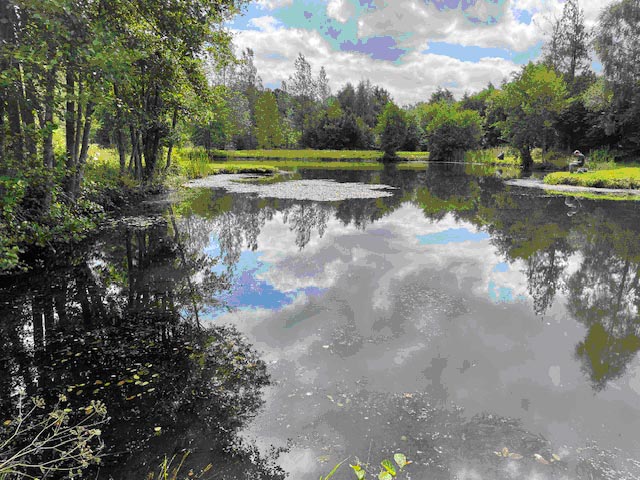
Picture 1: Weed at the top end
Picture 2: Mark
Orchin fishing the top lake
Thursday 18th
July: We opened the valve again at 8:30 Two of
us managed to catch a trout each from the top lake
on buzzers. These were transferred to the middle
lake (Picture 3). By 14:30 the water level was about
3 feet down. With no prospect of lowering the water
enough to enable netting of the remaining fish the
six of us abandoned the draining to the following
day. On the plus side, four of us went to Cinder
Hill during the morning and repaired the leaks in
the dam on McArthurs Pool. Just our luck that the
days we chose to drain the lake became the hottest
in July with temperatures up to 28 degrees. Not the
best conditions for trying to transfer trout.


Picture 3: Jonathan Barker trying to catch some
Picture 4: Top end almost dry
trout to transfer as the water is draining out
Friday 19th
July: The 3rd day. The valve was opened at 4:50
am by Dave Barrott who also tried to catch some fish
for a few hours but had no takes. By 3pm the water
level still wasnít low enough to safely net the
remaining fish so we abandoned again to a fourth
day, when we hoped that the last 3 to 4 feet of
water could be drained. (Pictures 4 and 5) With the
heat the water temperature was rising all the time
and as there was less and less water, would the remaining fish survive overnight.

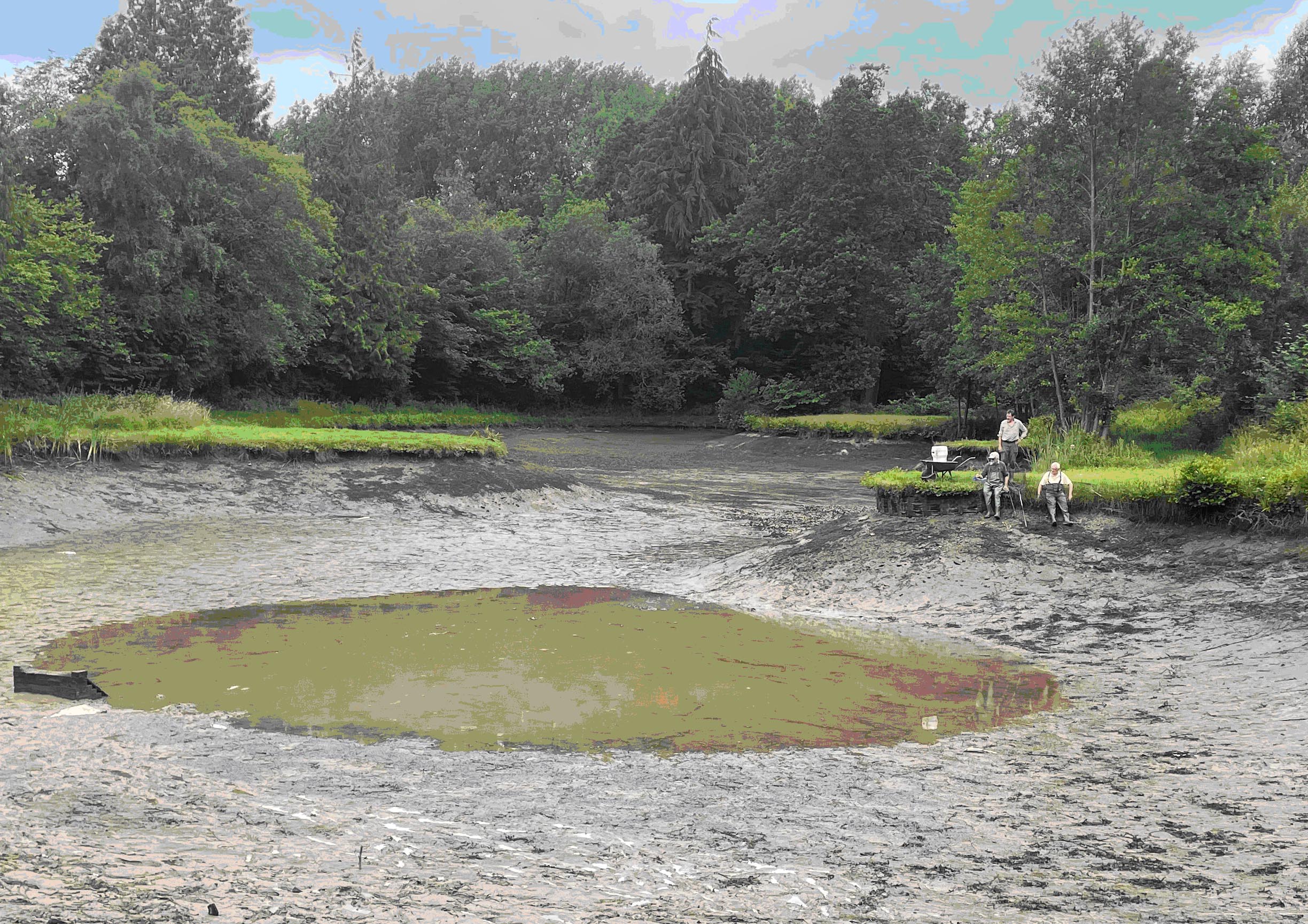
Picture 5: Still 3 to 4 feet of water left
Picture 6: From L to R, Dave Barrott, Les Everard
& Phil Stephens taking a rest after the netting
Saturday 20th
July: Dave Barrott once again opened the valve
at 5am and by 8:30 it was possible to start netting
the fish. Sadly 16 had perished overnight due to the
high temperatures and low oxygen, but we could see
plenty of fish in the remaining puddle and wondered
just how many had survived.
Dave had tried earlier on his own to transfer the
fish, but it took too long to get out of the mud
with the net and 2 fish died while trying. We tried using
crawler boards, but these were not very successful.
At one point, Dave stood on a board and was sliding
towards the water like he was on a surfboard. There
were four such boards under 12 inches of silt now.
Two further fish
died during the transfer to the middle lake in bins,
The good news was that 34 trout including a Sparctic
were successfully transferred. Sadly, we had to call
a halt at 12 noon as it was too dangerous for us to
try and catch the last 4 trout. Thick mud, tiredness
and fish moving out of reach of very long landing
nets meant the chances of getting any more was very
remote.
A very tired Dave Barrott, Phil Stephens and Les
Everard resting after a physically tiring morning.
Kevin Reeves taking the photo (Picture 6). The
outflow sluice can be clearly seen on the left edge
of the puddle.
During the
draining, some very small carp were taken by the
outflow into the bottom lake, so the carp problem
will come back again at some time in the future.
Thanks go to all those involved, but particularly to
Dave, Les and Phil who worked so hard on the final
day in very difficult conditions. Dave and Phil
getting stuck in the mud and silt more than once,
needing assistance to extract themselves. For
myself, I fell in the middle lake trying to fill a
bin with water and Les had to pull me out. I also
lost my specs in the process. The ironic
thing is I already had an eye test booked at the
opticians in the afternoon. What a poignant reminder
that you shouldnít attempt certain things on your
own.
Sunday 21st
July: The lakes were checked to see if any trout
had suffered in the transfer and thankfully, there
were no signs of any distressed or dead fish in the
middle lake. Pictures 7 & 8 show the top lake after
draining as much as possible. There was still some
water flowing into the lake from the stream and
surrounding fields which is why there was still a
puddle. Hopefully this would dry up over the next
four weeks prior to the machinery moving in.
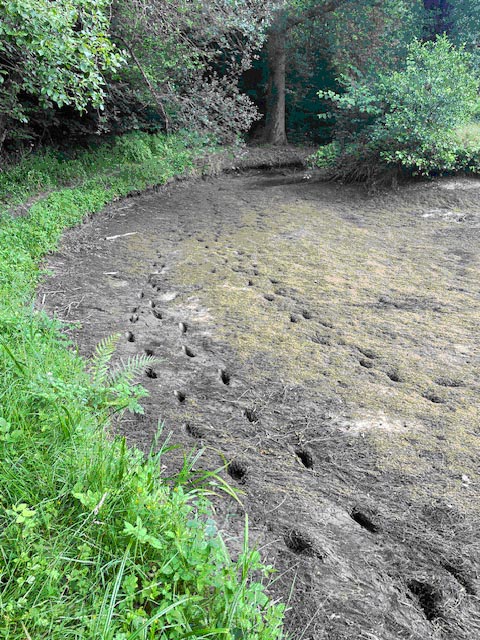
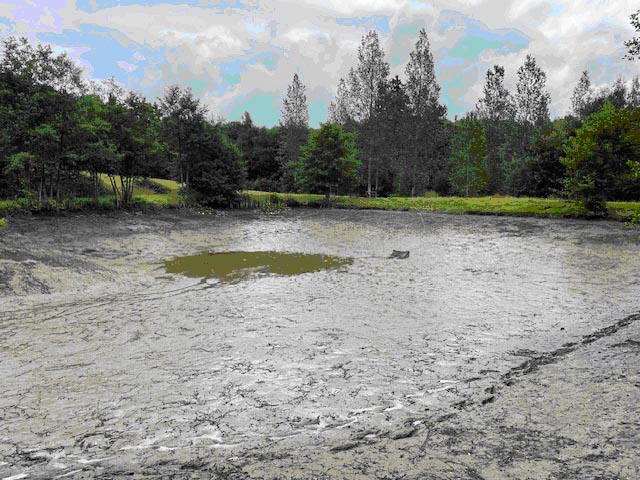
Picture 7: Top end showing silt
Picture 8: Small puddle left in top lake
with deer tracks
Thursday 1st
August: The heavens opened up for 2 hours
completely flooding the lake again with about five
feet of water! Following this flood event the dry
lakebed was wet again and all sorts of seeds started
germinating. (Picture 9). The lakebed finally dried
out as much as it was going to. Mark Orchin can be
seen balancing on the outlet brickwork trying not to
fall into the last area of wet mud behind him.
(Picture 10)

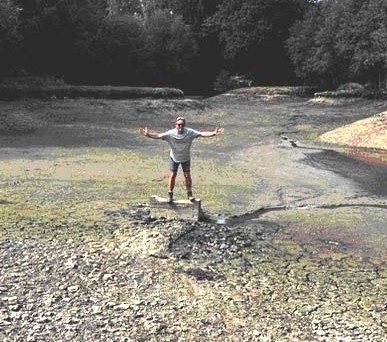
Picture 9: Lakebed coming
alive Picture10:
Day before dredging starts
Tuesday 27th
August: The dredging was due to
start on the 19th August but the adjacent field over
which the spoil was to be spread hadnít been
harvested due to the bad weather. It was therefore
delayed by a week until week commencing 26th August,
although we didnít start on the Monday because it
was a Bank Holiday and guess what, it rained again,
so the stream was still running with water. Dredging
finally started on the Tuesday afternoon and finished on
the afternoon of Monday 2nd
September. (Pictures 11, 12, 13)
After dredging, the lakebed was left for 12 days to
allow any stubborn weeds such as the broad leaf
pondweed to show so that they could be dug out and
the remaining roots treated with weed killer.


Picture 11: Digger working the top end
Picture 12: Silt 4 feet deep at the top end of the
lake


Picture 13: Digger and Muck Spreader
Picture 14: 15th September and
18 inches of water already
Saturday 14th
September: The outlet valve was closed to allow
the lake to refill.
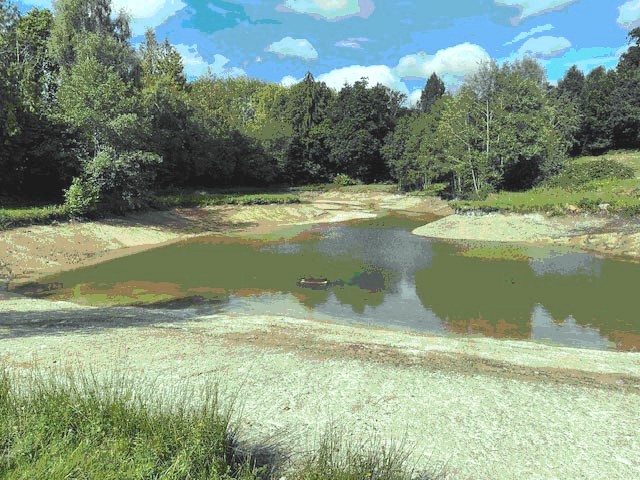

Picture 15: 3 feet of clear water
Picture 16: Full, muddy brown and overflowing
Tuesday 17th
September: 3 feet of crystal-clear water in 3
days, just from the flow in the feeder stream.
(Picture 15)
Saturday /
Sunday 21st / 22nd September: Autumn Show at
Ardingly and with heavy rains over the weekend the
lake filled overnight, coloured up and overflowing
with brown water, (more silt !) (Picture 16)
We wonder just how much of the silt we spread on the
adjacent field was washed back in. We then had to
wait for the water to clear before we introduced new
stock.
Thursday 10th
October: With the water now nice and crystal
clear, the lake was finally restocked and opened for
fishing, the trout subsequently proving very
obliging, providing excellent sport, some members
even saying the fishing was too easy !
20th July 2024 -
Desilting of Grubbero Pool
Grubbero Pool, the
top lake at Piplye, was last drained and de-silted
back in 2011. Since then the silt brought down in
the feeder stream and the weed growth, despite all
our attempts to control the latter, has built up to
the extent that the decision was made to again drain
the lake and mechanically remove the silt and weed
during the summer. To this end, the tap was opened
on the 17th July, and the water allowed to drain out
of the lake.
 Then followed an exhaustive four days by a team led by
Then followed an exhaustive four days by a team led by
Kevin Reeves,
our Chairman, to rescue and transfer
any remaining
fish into the middle lake. We were
amazed to find
around 50 plus trout surviving in the
remaining water,
thankfully a large number were saved
although sadly
some expired in the heat.
The lakebed will
then be left to dry out for 4 weeks, to
make the silt
and weed removal by digger
that much
easier, which is
scheduled to take place around the
middle of August
with the work expected to take 7 to 10
days. Once
complete, the lake will then be allowed to
refill,
hopefully we will have some rain to boost the flow
flow of the
feeder stream, .and if the lake fills up in time,
some fresh stock
will be introduced for some end of
season sport.
7th,
8th & 9th June 2024 - Sussex County Summer Show
We again had a
stand for the three days of the Sussex County
Agricultural Society Summer Show at Ardingly on the
7th, 8th & 9th June, where our marquee was situated
in it's usual position adjacent to a the pond. While
not quite so busy on the Friday, with the fine
weather all three days, we had a steady stream of
visitors and the instructors were kept busy with
persons of all ages wanting to have a go at fly
casting.
It was unfortunate that the powers that be had
decided to erect a permanent fence around the pond,
leaving a gap just wide enough to safely allow just
two persons under instruction at any one time, which
meant that there was a queue at times for those
waiting to have a go. We also had a good number of
anglers enquiring about membership of the Cinder
Hill Fly Fishing Syndicate to add to our waiting
list for the future.

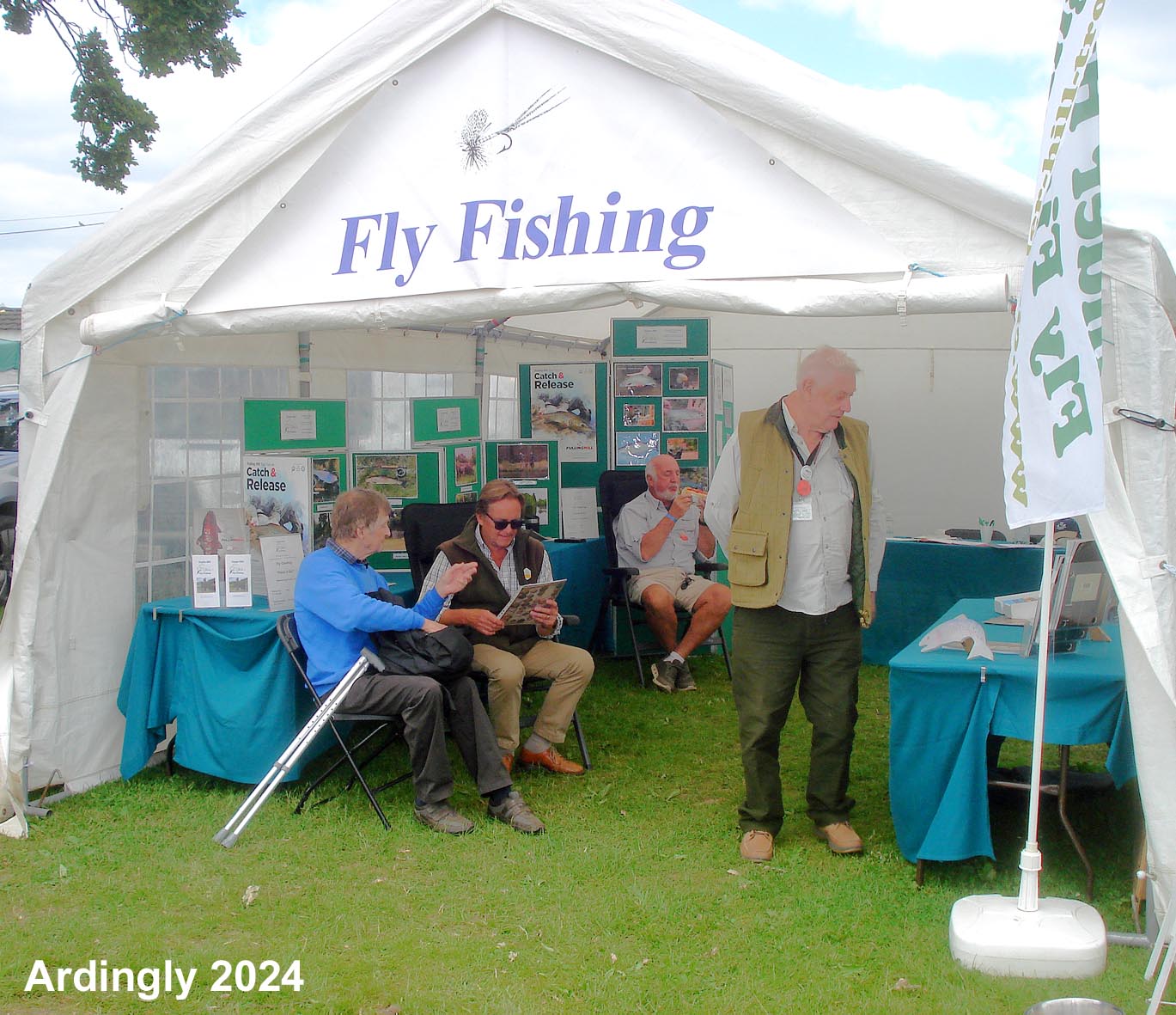

19th
May 2024 - Macmillan Charity Day
On Sunday the 19th
May at Cinder Hill, we held our 7th annual Charity
Fishing Day for Macmillan Cancer Support. The
day was very well supported by 25 members and
guests, the sun shone, it didn't rain and for most
the fishing was excellent. Once again many thanks go
to Val Orchin and Mandy Reeves for so efficiently
providing the food and drinks for the day with an
excellent barbeque and to Jim Awcock for supplying
the burgers, sausages etc.
In total we raised
an outstanding £900 to go with the £4785 we have
raised since the inaugural event back in 2017.
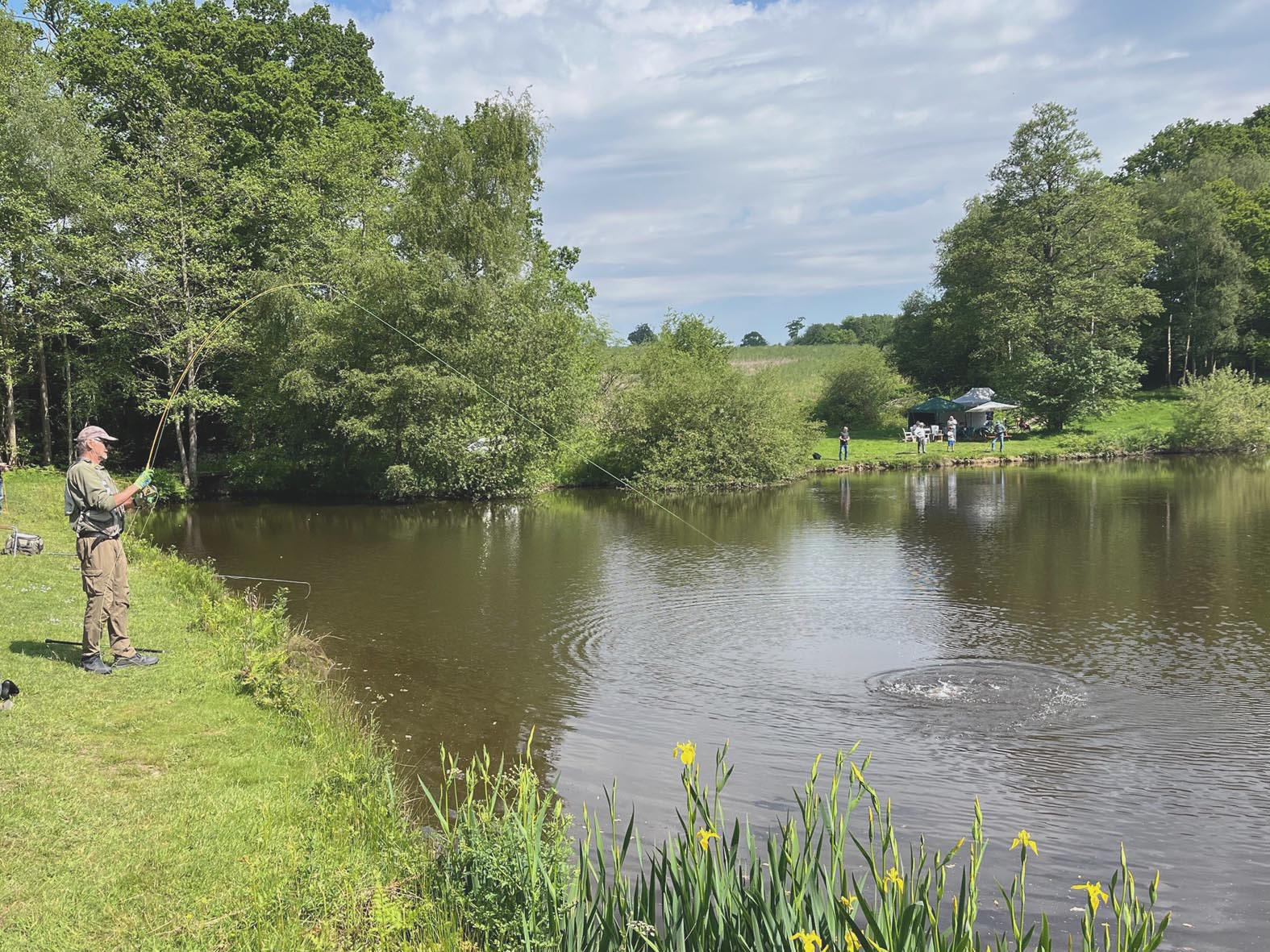
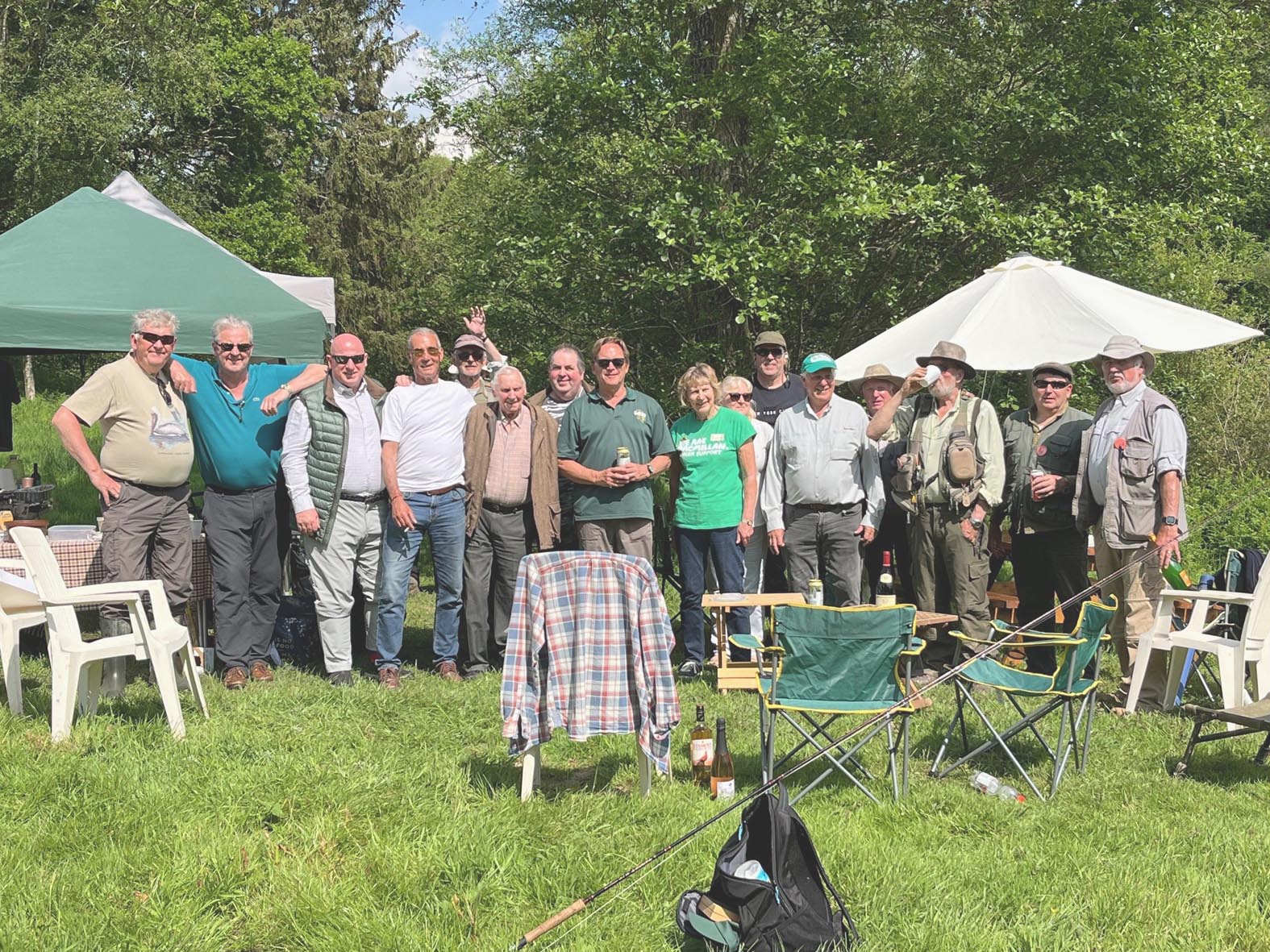
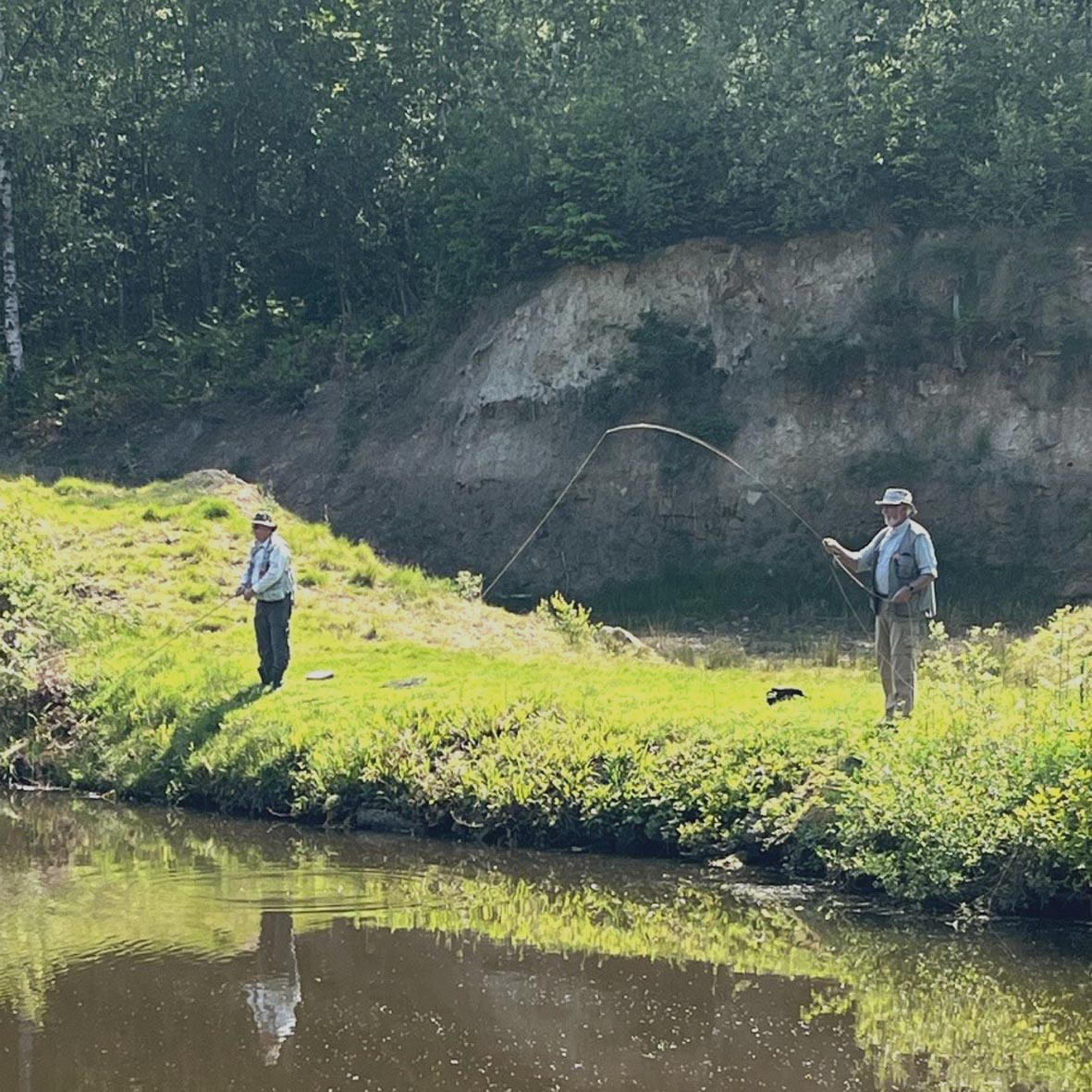
A big thank you to
all who took part and contributed to the day and
especially to member Laurie Storer, who started it
all off way back in 2017.